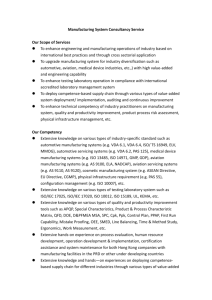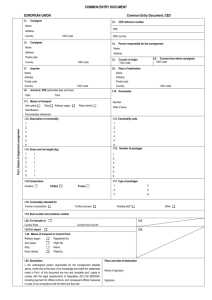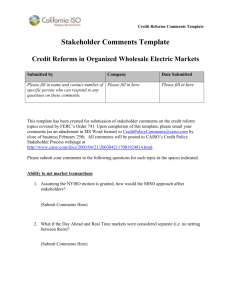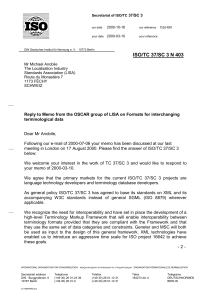Motion for Leave to File Answer and Answer of the California ISO in
advertisement
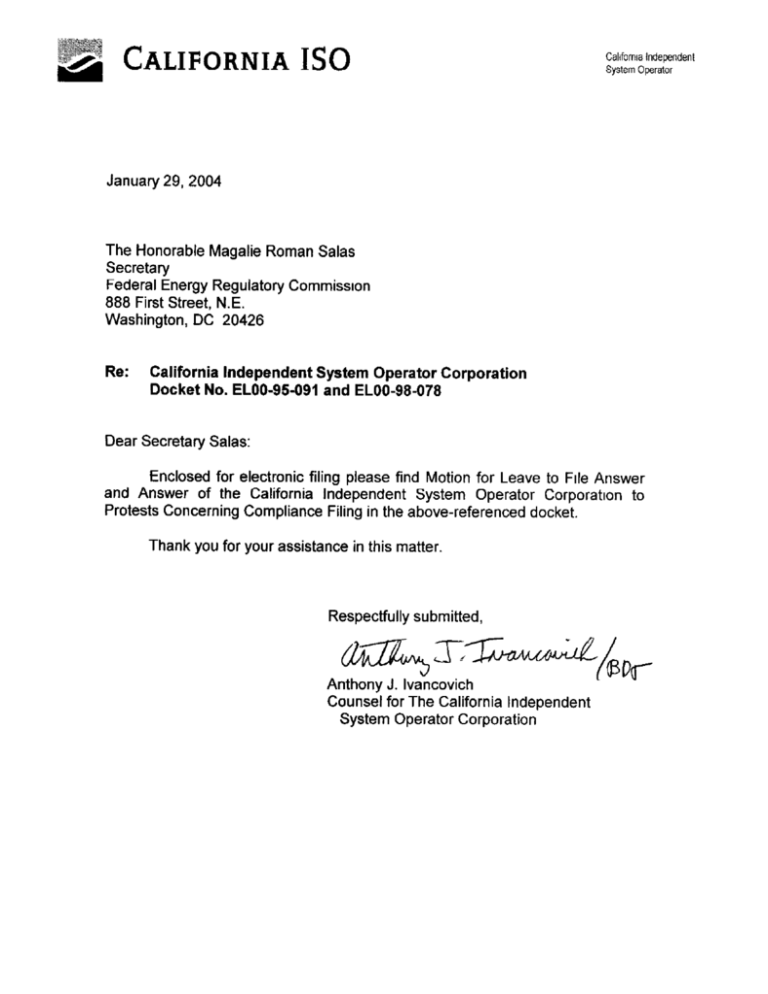
CALIFORNIA IS0 CalcfornlaIndependent SystemOperator January 29,2004 The Honorable Magalie Roman Salas Secretary Federal Energy Regulatory Commissron 888 First Street. N.E. Washington, DC 20426 Re: California Independent System Operator Corporation Docket No. ELOO-95-091 and ELOO-98-078 Dear Secretary Salas: Enclosed for electronic filing please find Motion for Leave to Frle Answer and Answer of the California Independent System Operator Corporatron to Protests Concerning Compliance Filing in the above-referenced docket. Thank you for your assistance in this matter. Respectfully submitted, Anthonv J. lvancovich Counsel for The California Independent System Operator Corporation UNITED STATES OF AMERICA BEFORE THE FEDERAL ENERGY REGULATORY COMMISSION San Diego Gas & Electric Company v. Sellers of Energy and Ancillary Services Into Markets Operated By the California Independent System Operator and the California Power Exchange ) ) ) ) ) ) Investigation of Practices of the California Independent System Operator And the California Power Exchange ) ) ) Docket No. EL00-95-091 Docket No. EL00-98-078 MOTION FOR LEAVE TO FILE ANSWER AND ANSWER OF THE CALIFORNIA INDEPENDENT SYSTEM OPERATOR CORPORATION TO PROTESTS CONCERNING COMPLIANCE FILING I. INTRODUCTION AND SUMMARY On November 14, 2003, the Commission issued an order on a compliance filing submitted by the ISO on April 13, 2003 in the above-captioned dockets. California Independent System Operator, 105 FERC ¶ 61,196 (2003) (“November 14 Order”). The ISO submitted complying Tariff modifications on December 15, 2003 (“December 15 Compliance Filing”). Three parties submitted protests or comments to the December 15 Compliance Filing.1 1 Protests of or comments on the December 15, 2003 compliance filing were submitted by the following entities: Dynegy Power Marketing, Inc., El Segundo Power, LLC, Long Beach Generation LLC, Cabrillo Power I LLC and Cabrillo Power II LLC (collectively, “Dynegy”) and Williams Power Company, Inc. (together, “Dynegy/Williams”); Mirant Americas Energy Marketing, LP, Mirant California, LLC; Mirant Delta, LLC and Mirant Potrero, LLC (collectively, “Mirant”); and Reliant Energy Power Generator, Inc. and Reliant Energy Services, Inc. (jointly, “Reliant”). 1 Pursuant to Rules 212 and 213 of the Commission’s Rules of Practice and Procedure, 18 C.F.R. §§ 385.212 and 385.213, the ISO hereby requests leave to file an answer and files its answer to certain of the protests and comments submitted in the above-referenced docket.2 The ISO requests that the Commission deny the protests and accept its December 15 Compliance Filing as submitted. II. ANSWER A. The Burden of Implementing Another Special-Purpose Demand ID Mechanism Outweighs Any Perceived Benefits Mirant contends that the ISO’s request for a stay of the November 14 Order is not supported by the facts. Mirant at 3-4. Specifically, Mirant states that the ISO created 106 Demand ID points to comply with the Commission’s October 17, 2003 order in Docket No. ER03-1221, California Independent System Operator Corporation, 105 FERC ¶ 61,074 (2003), and contends that creating approximately 200 additional Demand ID points is not unduly burdensome. Mirant’s argument does not withstand scrutiny. The number of Demand ID points is not the primary concern. The ISO designated existing Demand ID points for use in scheduling RMR Contract Energy, and could do the same thing for use in 2 The ISO requests waiver of Rule 213 (a)(2) (18 C.F.R. § 385.213 (a)(2)) to permit it to make this Answer. Good cause for this waiver exists here given the nature and complexity of this proceeding and the usefulness of this Answer in ensuring the development of a complete record. See, e.g., Enron Corp.,78 FERC ¶ 61,179, at 61,733, 61,741 (1997); El Paso Electric Co., 68 FERC ¶ 61,181, at 61,899 & n.57 (1994). The ISO seeks to correct certain misconceptions raised in the pleading filed by Mirant. While the ISO believes the additional protests are unfounded, they primarily concern issues related to pending rehearing requests and to the compliance filing itself. 2 scheduling Minimum Load Energy.3 The issue is that the ISO would have to integrate the special mechanism for scheduling Minimum Load Energy to specialpurpose Demand IDs into the Phase 1B modifications currently under way. As approved for Phase 1B4, Minimum Load Energy is deemed to be Instructed Imbalance Energy. To accomplish this, and at the same time to allow that Energy to be Scheduled against non-existent Demand at the special-purpose Demand IDs, the ISO will have to modify the Real-Time Market Applications module slated for implementation in Phase 1B to recognize that this particular kind of forward-Scheduled Energy is not really forward-Scheduled Energy but, for settlement purposes, Imbalance Energy. While Mirant asserts that “[o]bviously, there is a benefit to forward scheduling minimum load energy”5, it does not identify the nature of that obvious benefit. In Mirant’s July 15, 2002 Protest of Mirant to the Compliance Filing of the California Independent System Operator Corporation, Mirant’s argument that minimum load energy should be forward scheduled can be summed up in one phrase: the ISO said it was necessary to properly manage system reliability. While Mirant did not point to any specific ISO communication conveying this message, the ISO assumes Mirant was referring to Tariff Amendment No. 26. That amendment, submitted on January 28, 2000 and accepted by the 3 There is significant effort involved in activating existing Demand IDs for such scheduling purposes that must be carefully undertaken in accordance with ISO change management procedures to avoid any effects on existing systems and processes. 4 California Independent System Operator Corporation, 105 FERC ¶ 61, 091 (2003) at P 104. 5 Mirant at 4. 3 Commission on March 31, 20006 in Docket No. ER00-1365, proposed to modify Reliability Must-Run (RMR) Scheduling practices to provide greater assurance that RMR Energy would be Scheduled against actual Demand. In the transmittal letter for Tariff Amendment No. 26 (Docket ER00-1365), the ISO explained that un-Scheduled Energy appearing in real-time contributes to both reliability and market problems, including increased market volatility and an increased need to acquire and use more decremental Energy bids, which can from time to time be in short supply in the ISO’s Real-Time Imbalance Energy Market. To address these problems, Amendment No. 26 proposed mechanisms to maximize the amount of RMR Energy that would be Scheduled against actual Demand, not simply forward-Scheduled.7 The ISO has explained that unless the Minimum Load Energy is matched against real – not artificial – Demand, there is no additional benefit from forward scheduling it.8 Mirant mistakenly claims that the Commission rejected this argument when it rejected Amendment No. 56 in Docket ER03-1221. While the Commission rejected the ISO’s proposal to match RMR Contract Energy against actual Demand of the Scheduling Coordinator for the Responsible Utility, there is no indication from the Commission’s order on Amendment No. 56 that the Commission disagrees with the ISO’s position that unless Energy is Scheduled against actual Demand, the benefit of Scheduling 6 California Independent System Operator Corporation, 90 FERC ¶ 61,136 (2000). For example, all RMR Contract Energy the ISO instructed before the Day-Ahead market had to be bid into the California Power Exchange’s Day-Ahead Market at $0/MWh to maximize the likelihood that Energy would Scheduled against Demand. 8 See December 15, 2003 Motion for Clarification, Request for Rehearing, Motion for Stay, and Motion for Expedited Consideration of the California Independent System Operator Corporation submitted in Docket Nos. EL00-095-02 and EL-098-070 at 9-12. 7 4 that Energy is illusory. Moreover, implementing special-purpose Demand IDs for Scheduling RMR Contract Energy did not appreciably affect other ISO systems. In contrast, implementing special-purpose Demand IDs to use for Scheduling Minimum Load Energy will affect market systems currently in the final stages of development and testing. These additional burdens outweigh the illusory benefits of Scheduling Minimum Load Energy against non-existent Demand. B. The ISO Will Not Deem Energy Scheduled to the Special-Purpose Demand IDs as a Bilateral Transaction Citing the ISO’s December 15, 2003 Motion for Clarification in the abovecaptioned docket, Mirant expressed concern that the ISO would consider Energy Scheduled to special-purpose Demand IDs to be a bilateral transaction so as to deny Mirant Minimum Load Cost recovery. Mirant at 5-6. Although the ISO has expressed concerns about creating a special Scheduling mechanism that provides no substantive benefits9, the Mirant has no basis to assert that, after going to the trouble of creating another artificial Demand-based mechanism for the sole purpose of distinguishing Minimum Load Energy not sold and Scheduled via a bilateral transaction from Minimum Load Energy that is sold and Scheduled via a bilateral transaction, the ISO would then refuse to pay Minimum Load Costs for the Minimum Load Energy Scheduled to the special-purpose Demand ID. There would be no other purpose for these special-purpose Demand IDs. It is important to recognize, however, that Scheduling Minimum Load Energy to these 9 The ISO reminds the Commission that only one party at the July 29, 2003 technical conference convened to discuss a similar matter (scheduling RMR Contract Energy) expressed having difficulty finding a buyer for its RMR Contract Energy - Mirant. Furthermore, it appears that only Mirant has raised issues regarding scheduling Minimum Load Energy. 5 special-purpose Demand IDS will not obviate any effects on the real-hme Imbalance Energy price. Again thus results because the Demand scheduled to balance the Minimum Load Energy does not exrst. The Minimum Load Energy will still appear in real time un-Scheduled against actual Demand, reducing the amount of incremental Imbalance Energy and increasing the amount of decremental Imbalance Energy the IS0 would have Dispatched, all other things being equal. Ill. CONCLUSION For the foregoing reasons, the IS0 respectfully requests that the Commission accept the ISO’s December 15 Complrance Frling in the above- referenced dockets as submitted to the Commission. Respectfully submitted, Charles F. Robinson General Counsel Anthony lvancovich Senior Regulatory Counsel The Californra Independent System Operator Corporation 151 Blue Ravine Road Folsom. CA 95630 Date: January 29,2004 David B Rubin Bradley R Miliauskas Swrdler Berlin Shereff Friedman, 3000 K Street, NW Suite 300 Washington, DC 20007 LLP CERTIFICATE OF SERVICE I hereby certify that I have thts day served the foregoing document each person designated the above-captioned upon on the official service list compiled by the Secretary In docket. Dated at Folsom, California, on this 2gth day of January, 2004. Anthony J. lvancovich



